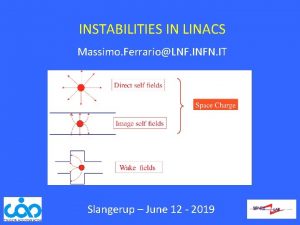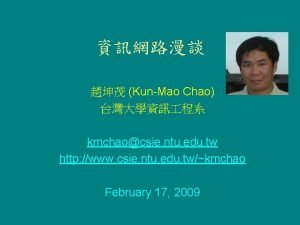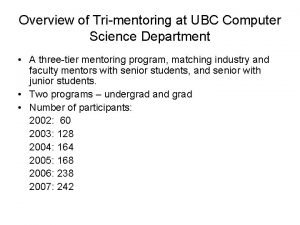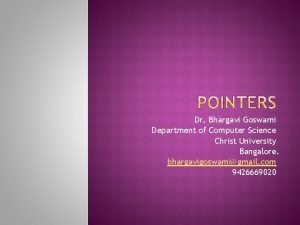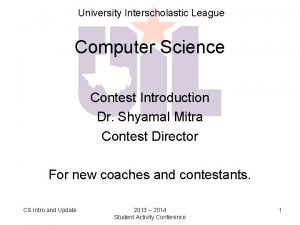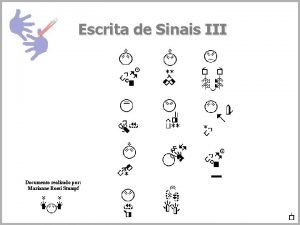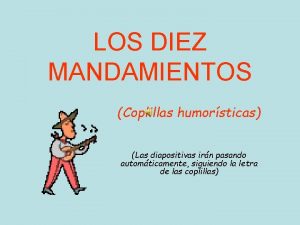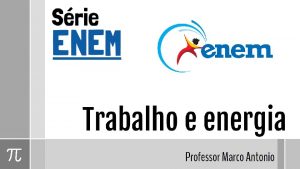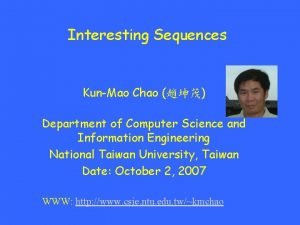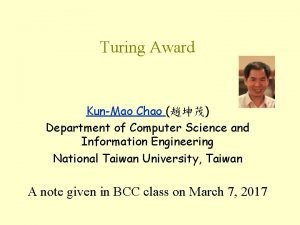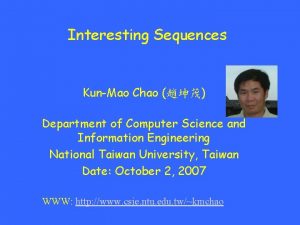Dynamic Programming KunMao Chao Department of Computer Science








![A naive approach for LIS • Let L[i] be the length of a longest A naive approach for LIS • Let L[i] be the length of a longest](https://slidetodoc.com/presentation_image_h/0f1bb30c634c141d10c7b80efb86261b/image-9.jpg)
![A naive approach for LIS L[i] = 1 + max j = 0. . A naive approach for LIS L[i] = 1 + max j = 0. .](https://slidetodoc.com/presentation_image_h/0f1bb30c634c141d10c7b80efb86261b/image-10.jpg)
![An O(n log n) method for LIS • Define Best. End[k] to be the An O(n log n) method for LIS • Define Best. End[k] to be the](https://slidetodoc.com/presentation_image_h/0f1bb30c634c141d10c7b80efb86261b/image-11.jpg)
![An O(n log n) method for LIS • Define Best. End[k] to be the An O(n log n) method for LIS • Define Best. End[k] to be the](https://slidetodoc.com/presentation_image_h/0f1bb30c634c141d10c7b80efb86261b/image-12.jpg)









- Slides: 21

Dynamic Programming Kun-Mao Chao (趙坤茂) Department of Computer Science and Information Engineering National Taiwan University, Taiwan E-mail: kmchao@csie. ntu. edu. tw WWW: http: //www. csie. ntu. edu. tw/~kmchao

Dynamic Programming • Dynamic programming is a class of solution methods for solving sequential decision problems with a compositional cost structure. • Richard Bellman was one of the principal founders of this approach. 2

Two key ingredients • Two key ingredients for an optimization problem to be suitable for a dynamicprogramming solution: 1. optimal substructures 2. overlapping subproblems Subproblems are dependent. Each substructure is optimal. (otherwise, a divide-andconquer approach is the (Principle of optimality) 3 choice. )

Three basic components • The development of a dynamicprogramming algorithm has three basic components: – The recurrence relation (for defining the value of an optimal solution); – The tabular computation (for computing the value of an optimal solution); – The traceback (for delivering an optimal solution). 4

Fibonacci numbers The Fibonacci numbers are defined by the following recurrence: F =0 0 F =1 1 F = F - + F - for i>1. i i 1 i 2 5

How to compute F 10? F 10 F 9 F 8 F 7 …… F 7 F 6 6

Tabular computation • The tabular computation can avoid recompuation. F 0 F 1 F 2 F 3 F 4 F 5 F 6 F 7 F 8 F 9 F 10 0 1 1 2 3 5 8 13 21 34 55 7

Longest increasing subsequence(LIS) • The longest increasing subsequence is to find a longest increasing subsequence of a given sequence of distinct integers a 1 a 2…an. e. g. 9 2 5 3 7 11 8 10 13 6 2 3 7 5 7 10 13 9 7 11 10 3 5 11 13 are increasing subsequences. We want to find a longest one. are not increasing subsequences. 8
![A naive approach for LIS Let Li be the length of a longest A naive approach for LIS • Let L[i] be the length of a longest](https://slidetodoc.com/presentation_image_h/0f1bb30c634c141d10c7b80efb86261b/image-9.jpg)
A naive approach for LIS • Let L[i] be the length of a longest increasing subsequence ending at position i. L[i] = 1 + max j = 0. . i-1{L[j] | aj < ai} (use a dummy a 0 = minimum, and L[0]=0) 9 2 5 3 7 11 8 10 13 6 L[i] 1 1 2 2 3 4 ? 9
![A naive approach for LIS Li 1 max j 0 A naive approach for LIS L[i] = 1 + max j = 0. .](https://slidetodoc.com/presentation_image_h/0f1bb30c634c141d10c7b80efb86261b/image-10.jpg)
A naive approach for LIS L[i] = 1 + max j = 0. . i-1 {L[j] | aj < ai} 9 2 5 3 7 11 8 10 13 6 L[i] 1 1 2 2 3 4 4 5 6 3 The maximum length The subsequence 2, 3, 7, 8, 10, 13 is a longest increasing subsequence. This method runs in O(n 2) time. 10
![An On log n method for LIS Define Best Endk to be the An O(n log n) method for LIS • Define Best. End[k] to be the](https://slidetodoc.com/presentation_image_h/0f1bb30c634c141d10c7b80efb86261b/image-11.jpg)
An O(n log n) method for LIS • Define Best. End[k] to be the smallest number of an increasing subsequence of length k. 9 2 5 3 7 11 8 10 13 9 2 2 3 7 11 2 3 7 8 10 13 2 5 2 3 7 6 Best. End[1] Best. End[2] Best. End[3] Best. End[4] Best. End[5] Best. End[6] 11
![An On log n method for LIS Define Best Endk to be the An O(n log n) method for LIS • Define Best. End[k] to be the](https://slidetodoc.com/presentation_image_h/0f1bb30c634c141d10c7b80efb86261b/image-12.jpg)
An O(n log n) method for LIS • Define Best. End[k] to be the smallest number of an increasing subsequence of length k. 9 2 5 3 7 11 8 10 13 9 2 2 3 7 11 2 3 7 8 10 13 2 5 2 3 7 For each position, we perform a binary search to update Best. End. Therefore, the running time is O(n log n). 6 2 3 6 8 10 13 Best. End[1] Best. End[2] Best. End[3] Best. End[4] Best. End[5] Best. End[6] 12

Longest Common Subsequence (LCS) • A subsequence of a sequence S is obtained by deleting zero or more symbols from S. For example, the following are all subsequences of “president”: pred, sdn, predent. • The longest common subsequence problem is to find a maximum-length common subsequence between two sequences. 15

LCS For instance, Sequence 1: president Sequence 2: providence Its LCS is priden. president providence 16

LCS Another example: Sequence 1: algorithm Sequence 2: alignment One of its LCS is algm. a l g o r i t h m a l i g n m e n t 17

How to compute LCS? • Let A=a 1 a 2…am and B=b 1 b 2…bn. • len(i, j): the length of an LCS between a 1 a 2…ai and b 1 b 2…bj • With proper initializations, len(i, j)can be computed as follows. 18

19

20

21

22

Longest Common Increasing Subsequence • Proposed by Yang, Huang and Chao – IPL 2005 • Improvement for some special case: – Katriel and Kutz (March 2005) – Chan, Zhang, Fung, Ye and Zhu (ISAAC 2005) 23
 Chao chao slangerup
Chao chao slangerup Kunmao
Kunmao Greedy programming vs dynamic programming
Greedy programming vs dynamic programming Meng computer science ucl
Meng computer science ucl Northwestern computer science department
Northwestern computer science department Computer science department rutgers
Computer science department rutgers Computer science department stanford
Computer science department stanford Fsu cybersecurity major
Fsu cybersecurity major Ubc computer science department
Ubc computer science department Bhargavi goswami
Bhargavi goswami Computer science department columbia
Computer science department columbia American computer science league practice problems
American computer science league practice problems Python programming an introduction to computer science
Python programming an introduction to computer science My favorite subject is art because
My favorite subject is art because Dysplastic obesity
Dysplastic obesity Paralelos chão
Paralelos chão Quy trình sản xuất chao
Quy trình sản xuất chao Jackson chao
Jackson chao Septimo sefirot
Septimo sefirot Shih chao-hwei
Shih chao-hwei Uma analise criteriosa do desempenho de usain bolt
Uma analise criteriosa do desempenho de usain bolt Batatinha quando nasce espalha a rama pelo chão
Batatinha quando nasce espalha a rama pelo chão
